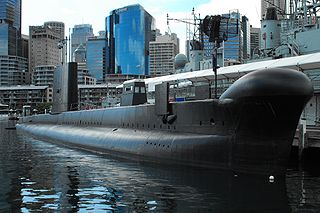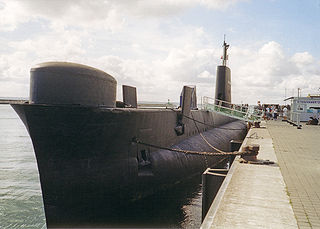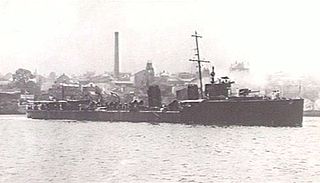
HMAS Queenborough (G70/D270/F02/57) was a Q-class destroyer that served in the Royal Navy (RN) and Royal Australian Navy (RAN).

HMAS Onslow is one of six Oberon-class submarines, decommissioned in 1999 and previously operated by the Royal Australian Navy (RAN). The submarine was named after the town of Onslow, Western Australia, and Sir Alexander Onslow, with the boat's motto and badge derived from Onslow's family heritage. Ordered in 1963, Onslow was laid down at the end of 1967 by Scotts Shipbuilding and Engineering Company in Scotland, launched almost a year later, and commissioned into the RAN at the end of 1969.

HMAS Melbourne (R21) was a Majestic-class light aircraft carrier operated by the Royal Australian Navy (RAN) from 1955 until 1982, and was the third and final conventional aircraft carrier to serve in the RAN. Melbourne was the only Commonwealth naval vessel to sink two friendly warships in peacetime collisions.

The Oberon class was a ship class of 27 British-designed submarines operated by five nations. They were designed as a follow-on from the Porpoise class; physical dimensions were the same but stronger materials were used in hull construction and improved equipment was fitted.

HMS Trump was a British submarine of the third group of the T class. She was built by Vickers-Armstrongs, Barrow, and launched on 25 March 1944. So far she has been the only ship of the Royal Navy (RN) to bear the name Trump. She spent the majority of her life attached to the 4th Submarine Squadron based in Australia. She was kept in service following the war and was refitted for greater underwater performance, and was the final RN submarine to be posted in Australia, departing in January 1969. She was sold off and broken up for scrap in August 1971.

HMAS Stuart was one of six River-class destroyer escorts built for the Royal Australian Navy (RAN). The ship was laid down by the Cockatoo Docks and Engineering Company at Cockatoo Island Dockyard in 1959, and commissioned into the RAN in 1963.

HMAS Anzac (D59) was a Battle-class destroyer of the Royal Australian Navy (RAN). Named after the Australian and New Zealand Army Corps, the destroyer was commissioned in 1951. The ship served on two tours of duty during the Korean War, and attempts to distinguish herself from British ships led to the practice of red kangaroo symbols on Australian warships. During 1956, Anzac served during the Malayan Emergency. In 1960, a malfunction in the destroyer's gun direction equipment caused Anzac to fire directly on sister ship HMAS Tobruk during a gunnery exercise, with Tobruk left unrepairable. In 1961, the destroyer was reclassified as a training vessel. Anzac remained in service until 1974, and was sold for breaking a year later.

HMAS Brisbane was a Town class light cruiser of the Royal Australian Navy (RAN). Built in Sydney between 1913 and 1916 to the Chatham subtype design, Brisbane operated in the Indian Ocean, Pacific Ocean, and Australian coastal waters during World War I.

HMAS Vampire was the third of three Australian-built Daring class destroyers serving in the Royal Australian Navy (RAN). One of the first all-welded ships built in Australia, she was constructed at Cockatoo Island Dockyard between 1952 and 1959, and was commissioned into the RAN a day after completion.

The Cockatoo Island Dockyard was a major dockyard in Sydney, Australia, based on Cockatoo Island. The dockyard was established in 1857 to maintain Royal Navy warships. It later built and repaired military and battle ships, and played a key role in sustaining the Royal Australian Navy. The dockyard was closed in 1991, and its remnants are heritage listed as the Cockatoo Island Industrial Conservation Area.

The River class was a class of six destroyer escorts operated by the Royal Australian Navy (RAN). Plans to acquire four vessels, based on the British Type 12M frigate, began in the 1950s. The first two vessels had some slight modifications to the design, while the next two underwent further changes. Two more ships were ordered in 1964, following the Melbourne-Voyager collision; these were based on the Type 12I frigate.

HMAS Yarra, named for the Yarra River, was a River-class torpedo-boat destroyer of the Royal Australian Navy (RAN). Ordered in 1909 for the Commonwealth Naval Forces, Yarra was temporarily commissioned into the Royal Navy on completion in 1910 and handed over to Australian control on arrival in Australia.

HMAS Huon (D50), named after the Huon River, was a River-class torpedo-boat destroyer of the Royal Australian Navy (RAN). Originally to be named after the River Derwent, the ship was renamed before her 1914 launch because of a naming conflict with a Royal Navy vessel.

The Fleet Base East is a Royal Australian Navy (RAN) major fleet base that comprises several naval establishments and facilities clustered around Sydney Harbour, centred on HMAS Kuttabul. The Fleet Base East extends beyond the borders of Kuttabul and includes the commercially-operated dockyard at Garden Island, and adjacent wharf facilities at nearby Woolloomooloo, east of the Sydney central business district in New South Wales, Australia. Fleet Base East is one of two major facilities of the RAN, the other facility being the Fleet Base West. The fleet operates in the Pacific Ocean.

HMAS Kookaburra (A331) was a Net-class boom defence vessel of the Royal Australian Navy (RAN), which served during World War II.

HMAS Otway was an Oberon-class submarine of the Royal Australian Navy (RAN). One of the first four Oberon-class boats ordered for the RAN, Otway was built in Scotland during the mid-1960s, and commissioned into naval service in 1968. The submarine was decommissioned in 1994. The submarine's upper casing, fin, and stern are preserved at Holbrook, New South Wales.

HMAS Oxley was an Oberon class submarine of the Royal Australian Navy (RAN).

HMS Tabard was a British submarine of the third group of the T class. She was built by Scotts, Greenock, and launched on 21 November 1945. So far she has been the only boat of the Royal Navy to bear the name Tabard, after the item of clothing. Having been launched after the war, she was selected, along with a number of boats of her class, to try out new streamlining techniques based on the German Type XXIII submarine. In May 1963, she was involved in a collision with HMAS Queenborough, and on 10 February 1964 she underwent exercises with HMAS Melbourne and HMAS Voyager in the hours before their collision. When she returned to the UK, she became the static training submarine at the shore establishment HMS Dolphin, until 1974 when she was sold and broken up.
HMAS Platypus is a former Royal Australian Navy (RAN) submarine base, located at 118 High Street, North Sydney with moorings in Neutral Bay, a suburb of Sydney in New South Wales, Australia. It was located upon the site of the Royal Australian Navy Torpedo Maintenance Establishment (RANTME), it built on the site of the former North Sydney Gas Works that operated on the site from 1877 and resumed by the Commonwealth in 1942. The Fleet Intermediate Maintenance Activity (FIMA) Workshops building on the site was originally used for torpedo assembly and storage during World War 2. It was later modified for submarine maintenance and repair, with a steel tower added to the northern end of the building for testing, cleaning and maintenance of periscopes.
The Cockatoo Docks & Engineering Company was a ship building and maintenance company which operated the Cockatoo Island Dockyard on Cockatoo Island in Sydney, Australia between 1933 and 1992.


















